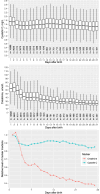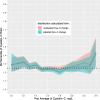Detecting Neonatal AKI by Serum Cystatin C
- PMID: 36977125
- PMCID: PMC10356146
- DOI: 10.1681/ASN.0000000000000125
Detecting Neonatal AKI by Serum Cystatin C
Abstract
Significance statement: Serum creatinine is not a sensitive biomarker for neonatal AKI because it is confounded by maternal creatinine level, gestational age, and neonatal muscle mass. In this multicenter cohort study of 52,333 hospitalized Chinese neonates, the authors proposed serum cystatin C-related criteria (CyNA) for neonatal AKI. They found that cystatin C (Cys-C) is a robust and sensitive biomarker for identifying AKI in neonates who are at an elevated risk of in-hospital mortality and that CyNA detects 6.5 times as many cases as the modified Kidney Disease Improving Global Outcomes creatinine criteria. They also show that AKI can be detected using a single test of Cys-C. These findings suggest that CyNA shows promise as a powerful and easily applicable tool for detecting AKI in neonates.
Background: Serum creatinine is not a sensitive biomarker for AKI in neonates. A better biomarker-based criterion for neonatal AKI is needed.
Methods: In this large multicenter cohort study, we estimated the upper normal limit (UNL) and reference change value (RCV) of serum cystatin C (Cys-C) in neonates and proposed cystatin C-based criteria (CyNA) for detecting neonatal AKI using these values as the cutoffs. We assessed the association of CyNA-detected AKI with the risk of in-hospital death and compared CyNA performance versus performance of modified Kidney Disease Improving Global Outcomes (KDIGO) creatinine criteria.
Results: In this study of 52,333 hospitalized neonates in China, Cys-C level did not vary with gestational age and birth weight and remained relatively stable during the neonatal period. CyNA criteria define AKI by a serum Cys-C of ≥2.2 mg/L (UNL) or an increase in Cys-C of ≥25% (RCV) during the neonatal period. Among 45,839 neonates with measurements of both Cys-C and creatinine, 4513 (9.8%) had AKI detected by CyNA only, 373 (0.8%) by KDIGO only, and 381 (0.8%) by both criteria. Compared with neonates without AKI by both criteria, neonates with AKI detected by CyNA alone had an increased risk of in-hospital mortality (hazard ratio [HR], 2.86; 95% confidence interval [95% CI], 2.02 to 4.04). Neonates with AKI detected by both criteria had an even higher risk of in-hospital mortality (HR, 4.86; 95% CI, 2.84 to 8.29).
Conclusions: Serum Cys-C is a robust and sensitive biomarker for detecting neonatal AKI. Compared with modified KDIGO creatinine criteria, CyNA is 6.5 times more sensitive in identifying neonates at elevated risk of in-hospital mortality.
Copyright © 2023 by the American Society of Nephrology.
Figures




Similar articles
-
Plasma cystatin C versus renal resistive index as early predictors of acute kidney injury in critically ill neonates.J Pediatr Urol. 2020 Apr;16(2):206.e1-206.e8. doi: 10.1016/j.jpurol.2019.12.001. Epub 2019 Dec 6. J Pediatr Urol. 2020. PMID: 31926796
-
Cystatin C compared to serum creatinine as a marker of acute kidney injury in critically ill neonates.Pediatr Nephrol. 2021 Jan;36(1):181-186. doi: 10.1007/s00467-020-04668-3. Epub 2020 Jun 27. Pediatr Nephrol. 2021. PMID: 32594242
-
Serum cystatin C- versus creatinine-based definitions of acute kidney injury following cardiac surgery: a prospective cohort study.Am J Kidney Dis. 2012 Dec;60(6):922-9. doi: 10.1053/j.ajkd.2012.06.002. Epub 2012 Jul 17. Am J Kidney Dis. 2012. PMID: 22809763 Free PMC article.
-
Serum Cystatin C as a predictor of acute kidney injury in neonates: a meta-analysis.J Pediatr (Rio J). 2022 May-Jun;98(3):230-240. doi: 10.1016/j.jped.2021.08.005. Epub 2021 Oct 16. J Pediatr (Rio J). 2022. PMID: 34662539 Free PMC article. Review.
-
Urinary, Plasma, and Serum Biomarkers' Utility for Predicting Acute Kidney Injury Associated With Cardiac Surgery in Adults: A Meta-analysis.Am J Kidney Dis. 2015 Dec;66(6):993-1005. doi: 10.1053/j.ajkd.2015.06.018. Epub 2015 Aug 5. Am J Kidney Dis. 2015. PMID: 26253993 Review.
Cited by
-
N-terminal pro-B-type natriuretic peptide, eGFR, and progression of kidney disease in chronic kidney disease patients without heart failure.Clin Kidney J. 2024 Sep 30;17(10):sfae298. doi: 10.1093/ckj/sfae298. eCollection 2024 Oct. Clin Kidney J. 2024. PMID: 39464259 Free PMC article.
-
Kidney function-specific cut-off values of high-sensitivity cardiac troponin T for the diagnosis of acute myocardial infarction.Clin Kidney J. 2024 Aug 23;17(9):sfae247. doi: 10.1093/ckj/sfae247. eCollection 2024 Sep. Clin Kidney J. 2024. PMID: 39246629 Free PMC article.
-
Renin-angiotensin system inhibitors and risk of hepatocellular carcinoma among patients with hepatitis B virus infection.CMAJ. 2024 Aug 11;196(27):E931-E939. doi: 10.1503/cmaj.240003. CMAJ. 2024. PMID: 39134317 Free PMC article.
-
Inverse association between serum chloride levels and the risk of atrial fibrillation in chronic kidney disease patients.Clin Kidney J. 2024 May 13;17(8):sfae137. doi: 10.1093/ckj/sfae137. eCollection 2024 Aug. Clin Kidney J. 2024. PMID: 39131078 Free PMC article.
-
Associations between Different Antivirals and Hospital-Acquired Acute Kidney Injury in Adults with Herpes Zoster.Clin J Am Soc Nephrol. 2024 Jun 1;19(6):694-703. doi: 10.2215/CJN.0000000000000452. Epub 2024 Mar 26. Clin J Am Soc Nephrol. 2024. PMID: 38527975
References
Publication types
MeSH terms
Substances
LinkOut - more resources
Full Text Sources

